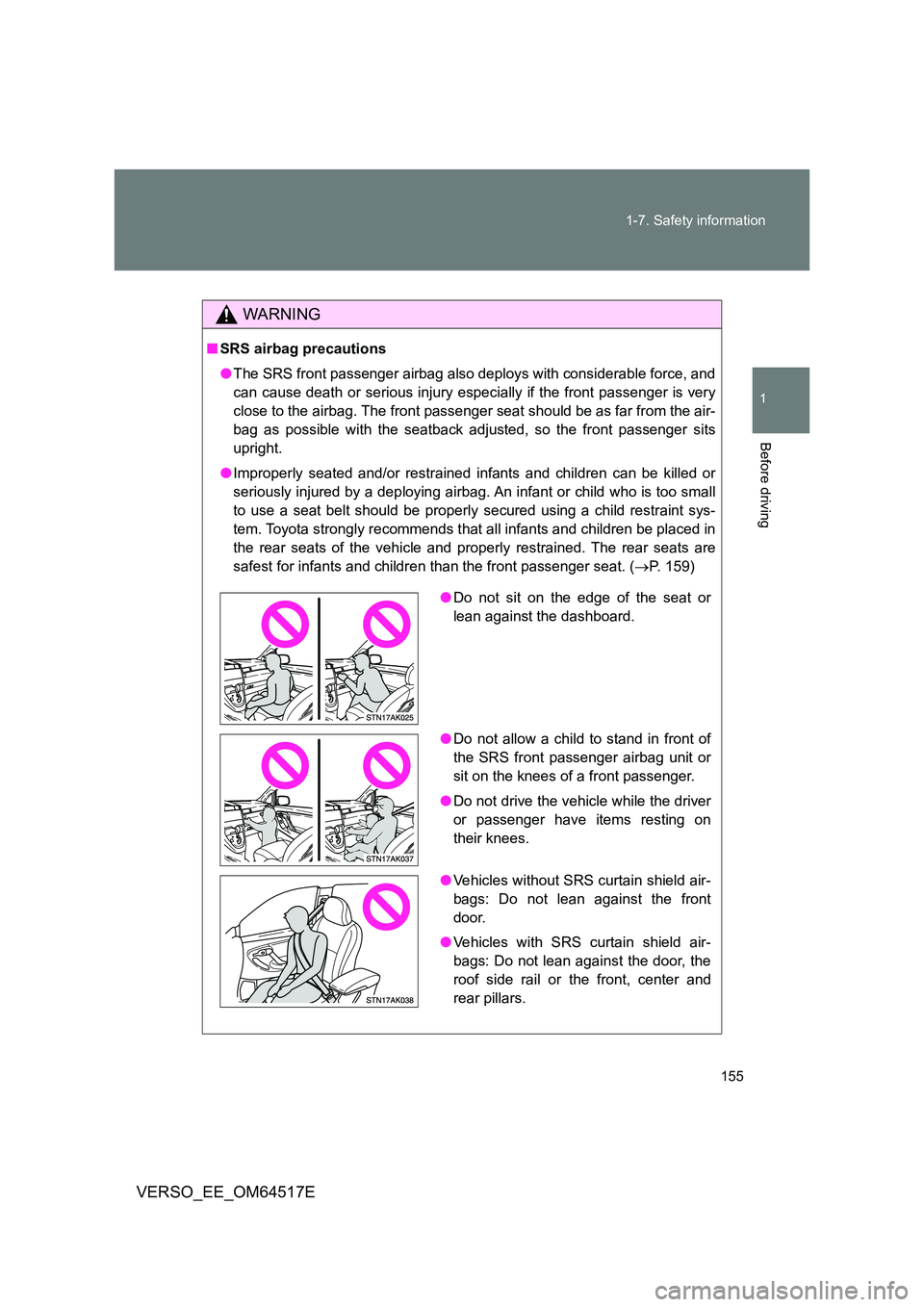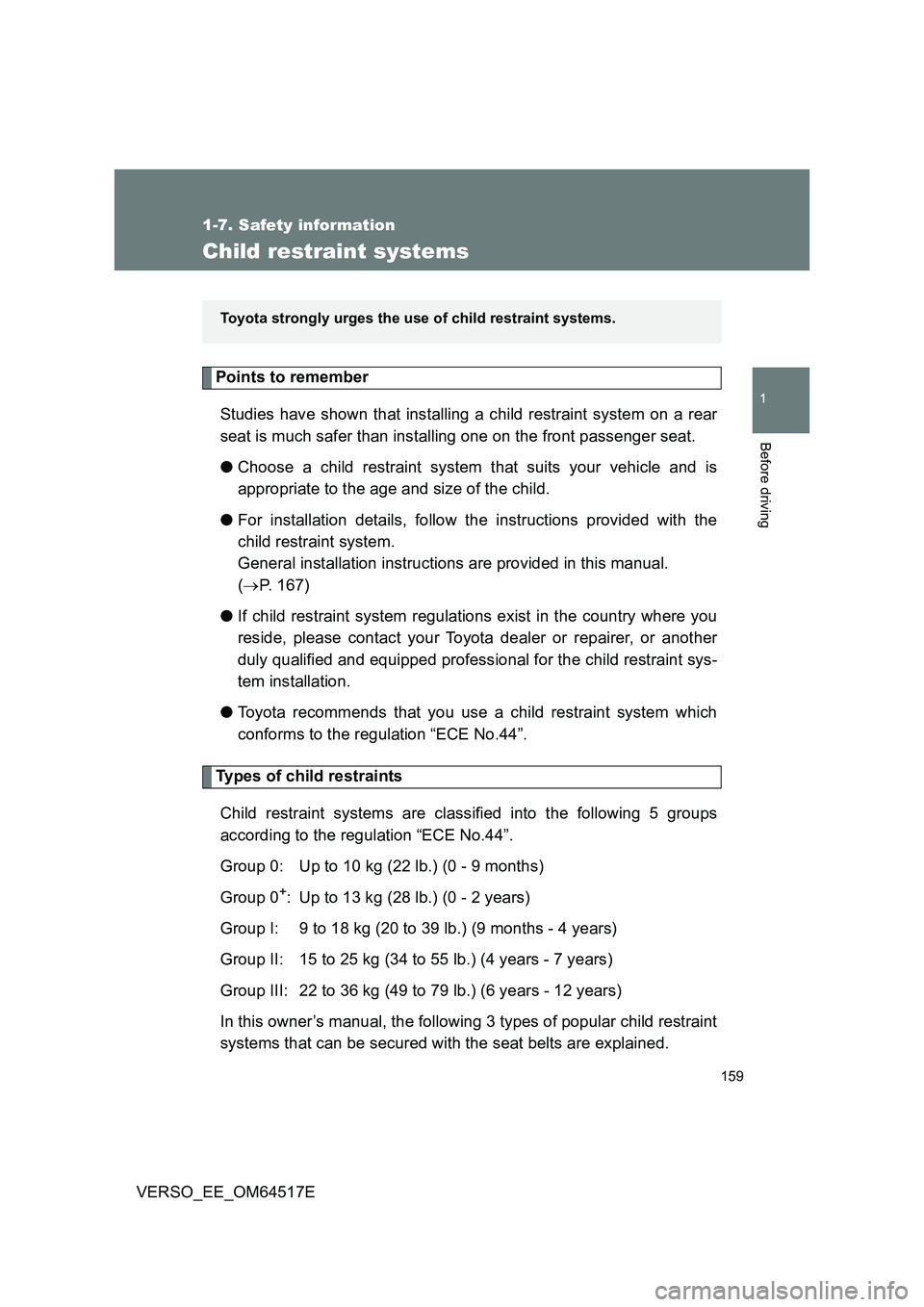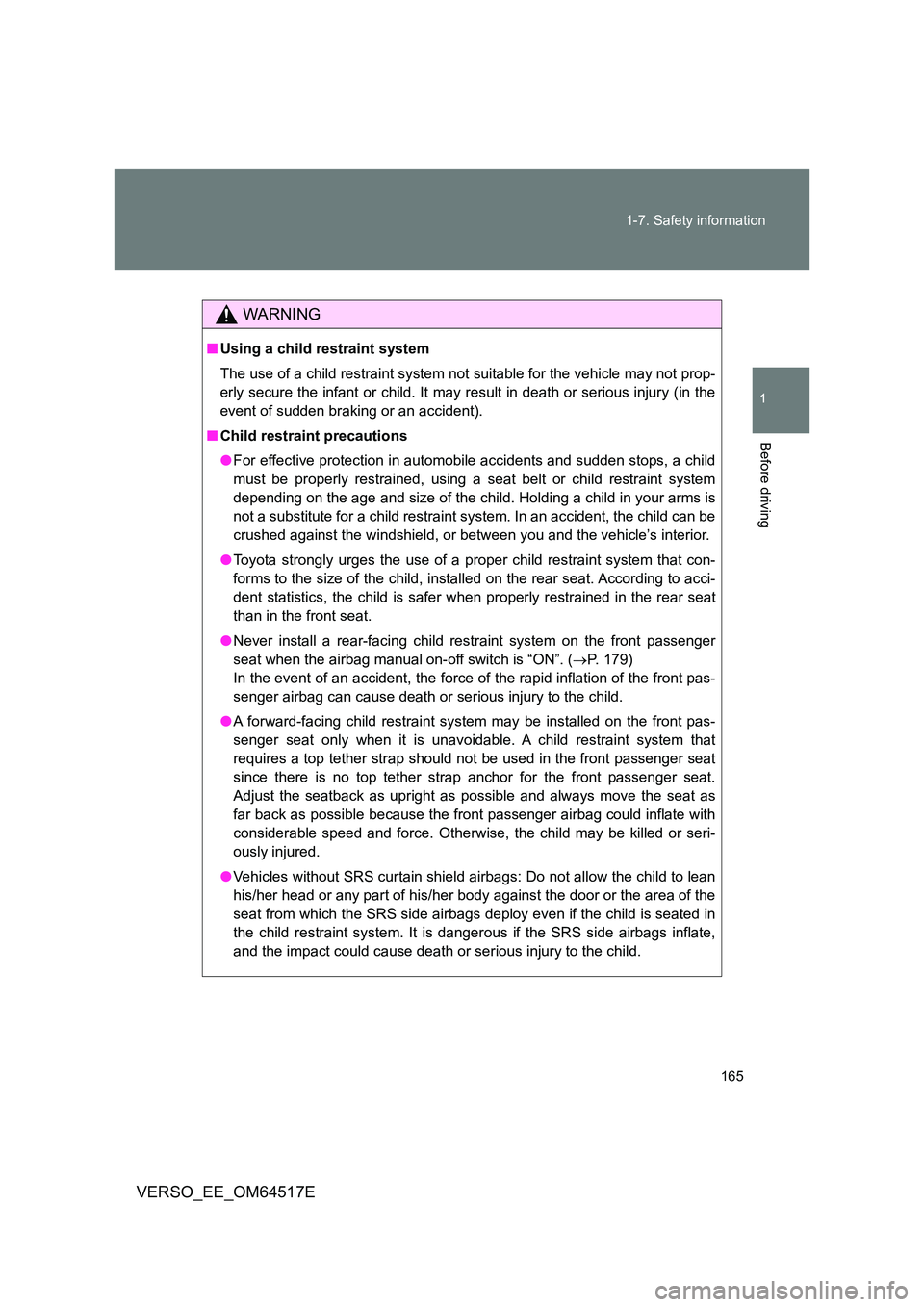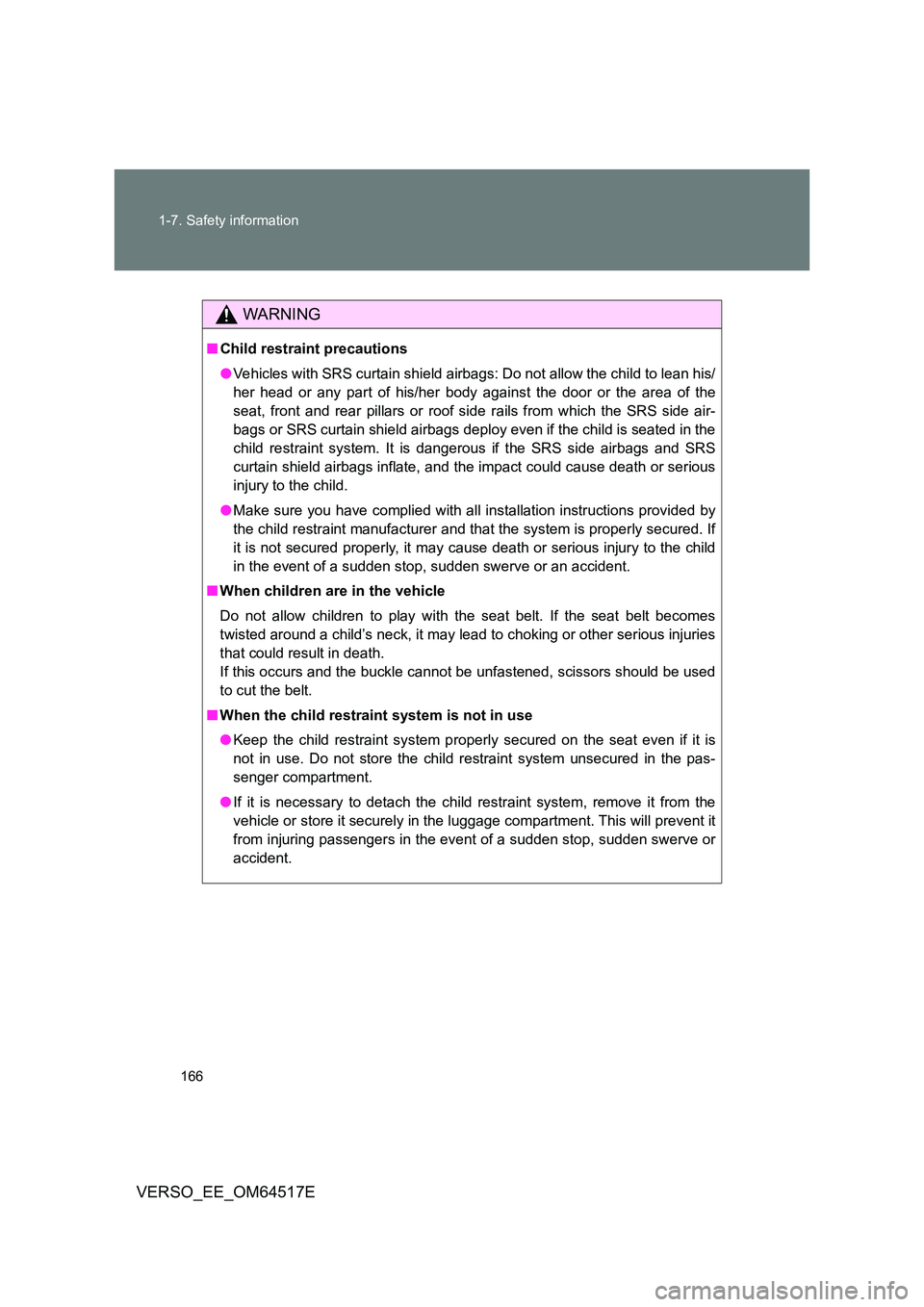Page 139 of 668

139
1-6. Theft deterrent system
1
Before driving
VERSO_EE_OM64517E
Intrusion sensor (if equipped)
The intrusion sensor detects an intruder or movement in the vehicle.
The intrusion sensor can be canceled using the cancel switch.
This system is designed to deter and prevent vehicle theft but does
not guarantee absolute security against all intrusions.
■ Canceling the intrusion sensor
Vehicles without smart entry &
start system: Turn the engine
switch to the “LOCK” position
and press the intrusion sensor
cancel switch.
Vehicles with smart entry & start
system: Turn the “ENGINE
START STOP” switch off and
press the intrusion sensor cancel
switch.
Pressing the switch again will re-
enable the intrusion sensor.
To cancel the intrusion sensor, perform the necessary procedure
each time canceling the sensor is desired.
■ Deactivating or stopping the alarm
Do one of the following to deactivate or stop the alarm.
● Unlock the doors using the entry function (vehicles with smart
entry & start system) or wireless remote control.
● Start the engine. (The alarm will be deactivated or stopped
after a few seconds.)
Page 155 of 668

155
1-7. Safety information
1
Before driving
VERSO_EE_OM64517E
WARNING
■ SRS airbag precautions
● The SRS front passenger airbag also deploys with considerable force, and
can cause death or serious injury especially if the front passenger is very
close to the airbag. The front passenger seat should be as far from the air-
bag as possible with the seatback adjusted, so the front passenger sits
upright.
● Improperly seated and/or restrained infants and children can be killed or
seriously injured by a deploying airbag. An infant or child who is too small
to use a seat belt should be properly secured using a child restraint sys-
tem. Toyota strongly recommends that all infants and children be placed in
the rear seats of the vehicle and proper ly restrained. The rear seats are
safest for infants and children than the front passenger seat. ( P. 159)
●Do not sit on the edge of the seat or
lean against the dashboard.
● Do not allow a child to stand in front of
the SRS front passenger airbag unit or
sit on the knees of a front passenger.
● Do not drive the vehicle while the driver
or passenger have items resting on
their knees.
● Vehicles without SRS curtain shield air-
bags: Do not lean against the front
door.
● Vehicles with SRS curtain shield air-
bags: Do not lean against the door, the
roof side rail or the front, center and
rear pillars.
Page 159 of 668

159
1
1-7. Safety information
Before driving
VERSO_EE_OM64517E
Child restraint systems
Points to remember
Studies have shown that installing a child restraint system on a rear
seat is much safer than installing one on the front passenger seat.
● Choose a child restraint system that suits your vehicle and is
appropriate to the age and size of the child.
● For installation details, follow the instructions provided with the
child restraint system.
General installation instructions are provided in this manual.
( P. 167)
● If child restraint system regulations exist in the country where you
reside, please contact your Toyota dealer or repairer, or another
duly qualified and equipped professional for the child restraint sys-
tem installation.
● Toyota recommends that you use a child restraint system which
conforms to the regulation “ECE No.44”.
Types of child restraints
Child restraint systems are classified into the following 5 groups
according to the regulation “ECE No.44”.
Group 0: Up to 10 kg (22 lb.) (0 - 9 months)
Group 0+: Up to 13 kg (28 lb.) (0 - 2 years)
Group I: 9 to 18 kg (20 to 39 lb.) (9 months - 4 years)
Group II: 15 to 25 kg (34 to 55 lb.) (4 years - 7 years)
Group III: 22 to 36 kg (49 to 79 lb.) (6 years - 12 years)
In this owner’s manual, the following 3 types of popular child restraint
systems that can be secured with the seat belts are explained.
Toyota strongly urges the u se of child restraint systems.
Page 165 of 668

165
1-7. Safety information
1
Before driving
VERSO_EE_OM64517E
WARNING
■ Using a child restraint system
The use of a child restraint system not suitable for the vehicle may not prop-
erly secure the infant or child. It may result in death or serious injury (in the
event of sudden braking or an accident).
■ Child restraint precautions
● For effective protection in automobile accidents and sudden stops, a child
must be properly restrained, using a seat belt or child restraint system
depending on the age and size of the child. Holding a child in your arms is
not a substitute for a child restraint system. In an accident, the child can be
crushed against the windshield, or between you and the vehicle’s interior.
● Toyota strongly urges the use of a proper child restraint system that con-
forms to the size of the child, installed on the rear seat. According to acci-
dent statistics, the child is safer w hen properly restrained in the rear seat
than in the front seat.
● Never install a rear-facing child restraint system on the front passenger
seat when the airbag manual on-off switch is “ON”. ( P. 179)
In the event of an accident, the force of the rapid inflation of the front pas-
senger airbag can cause death or serious injury to the child.
● A forward-facing child restraint system may be installed on the front pas-
senger seat only when it is unavoidable. A child restraint system that
requires a top tether strap should not be used in the front passenger seat
since there is no top tether strap anchor for the front passenger seat.
Adjust the seatback as upright as possible and always move the seat as
far back as possible because the front passenger airbag could inflate with
considerable speed and force. Otherwise, the child may be killed or seri-
ously injured.
● Vehicles without SRS curtain shield airbags: Do not allow the child to lean
his/her head or any part of his/her body against the door or the area of the
seat from which the SRS side airbags deploy even if the child is seated in
the child restraint system. It is dangerous if the SRS side airbags inflate,
and the impact could cause death or serious injury to the child.
Page 166 of 668

166
1-7. Safety information
VERSO_EE_OM64517E
WARNING
■ Child restraint precautions
● Vehicles with SRS curtain shield airbags: Do not allow the child to lean his/
her head or any part of his/her body against the door or the area of the
seat, front and rear pillars or roof side rails from which the SRS side air-
bags or SRS curtain shield airbags deploy even if the child is seated in the
child restraint system. It is dangerous if the SRS side airbags and SRS
curtain shield airbags inflate, and the impact could cause death or serious
injury to the child.
● Make sure you have complied with all installation instructions provided by
the child restraint manufacturer and that the system is properly secured. If
it is not secured properly, it may cause death or serious injury to the child
in the event of a sudden stop, sudden swerve or an accident.
■ When children are in the vehicle
Do not allow children to play with the seat belt. If the seat belt becomes
twisted around a child’s neck, it may lead to choking or other serious injuries
that could result in death.
If this occurs and the buckle cannot be unfastened, scissors should be used
to cut the belt.
■ When the child restraint system is not in use
● Keep the child restraint system properly secured on the seat even if it is
not in use. Do not store the child restraint system unsecured in the pas-
senger compartment.
● If it is necessary to detach the child restraint system, remove it from the
vehicle or store it securely in the luggage compartment. This will prevent it
from injuring passengers in the event of a sudden stop, sudden swerve or
accident.
Page 167 of 668
167
1
1-7. Safety information
Before driving
VERSO_EE_OM64517E
Installing child restraints
Follow the child restraint system manufacturer’s instructions. Firmly
secure the child restraints to the seats using a seat belt or ISOFIX
rigid anchor. Attach the top strap when installing a child restraint
system.
Seat belts (An ELR belt
requires a locking clip.)
Second seat: ISOFIX rigid
anchor (ISOFIX child restraint
system)
Lower anchors are provided for
the outside second seats.
(Labels displaying the location
of the anchors are attached to
the seats.)
Second seat: Anchor bracket
(for top strap)
Anchor brackets are provided
for outside second seats.
Page 168 of 668
168
1-7. Safety information
VERSO_EE_OM64517E
Installing child restraints using a seat belt
■ Rear-facing Baby seat/child seat
Second seats
Adjust the seat as far back as
possible.
Fold the seatback while pulling
up the seatback angle adjust-
ment lever. Return the seatback
and secure it at the 1st lock posi-
tion (most upright position).
( P. 8 6 )
Third seats (vehicles with third seats)
Adjust the second seat forward
so that it does not interfere with
the child restraint system.
Fold the seatback while pulling
the seatback angle adjustment
strap. Return the seatback and
secure it at the 1st lock position
(most upright position). ( P. 8 7 )
Place the child seat on the rear
seat facing the rear of the vehi-
cle.
Page 169 of 668
169
1-7. Safety information
1
Before driving
VERSO_EE_OM64517E
Run the seat belt through the
child seat and insert the plate
into the buckle. Make sure that
the belt is not twisted.
Install a locking clip near the tab
of the lap and shoulder belt by
inserting the lap and shoulder
webbing through the recesses of
the locking clip. Buckle the belt
again. If the belt has any slack,
release the buckle and reinstall
the locking clip.
■ Forward-facing Child seat
Second seats
Adjust the seat as far back as
possible.
Fold the seatback while pulling
up the seatback angle adjust-
ment lever. Return the seatback
and secure it at the 1st lock posi-
tion (most upright position).
( P. 8 6 )